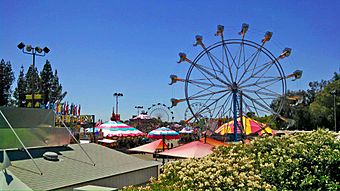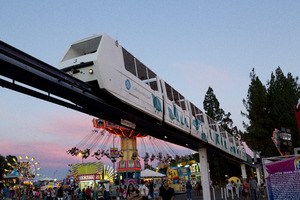California State Fair facts for kids
Quick facts for kids California State Fair |
|
|---|---|

The California State Fair on its opening day in 2014.
|
|
| Genre | State fair |
| Location(s) | Sacramento, California |
| Years active | 1854–1916; 1919–1941; 1948–2019; 2022– |
| Attendance | 652,873 (2022) |
| Website | California State Fair |
The California State Fair is a huge, 17-day festival held every year in Sacramento, California. It takes place at a special location called Cal Expo. The fair is a giant celebration of everything that makes California special, from its farms to its diverse people.
Visitors can enjoy all kinds of fun activities. You can see prize-winning animals, taste delicious food, watch cooking contests, and go to live music concerts. There's also a big carnival with rides, games, and a fireworks show every night. It's a popular event, with tens of thousands of people visiting each day.
The fair was paused in 2020 and 2021 because of the COVID-19 pandemic. During that time, the fairgrounds were used to help the community in other ways.
Contents
History of the Fair
How It All Began
Back in the 1850s, soon after California became a state, people thought it was an amazing place with incredible resources. They wanted to create a grand fair to show off everything the state had to offer, from fruits and vegetables to livestock.
In 1854, the California State Legislature created the State Agricultural Society. They planned the very first state fair and offered $5,000 in prize money for the best exhibits, which was a lot of money back then!
A Traveling Fair
The first California State Fair opened on October 4, 1854, in San Francisco. For the next few years, the fair didn't have a permanent home. It traveled to a different city each year. After San Francisco, it was held in:
- Sacramento (1855)
- San Jose (1856)
- Stockton (1857)
- Marysville (1858)
Finding a Home in Sacramento
The fair returned to Sacramento in 1859 and soon found a permanent home there. A special building called Agricultural Hall was built for the exhibits. The fair became so popular that people from all over California traveled to Sacramento to see the new farm machines, enjoy the entertainment, and compete for prizes.
Over the years, the fair grew too big for its location. In 1909, it moved to a larger site on Stockton Boulevard. The fair was paused from 1942 to 1947 during World War II, when the grounds were used by the military.
Moving to Cal Expo
In 1968, the State Fair moved to its current home, a huge site called California Exposition, or Cal Expo for short. This new location is north of the American River in Sacramento and has plenty of space for all the fair's attractions.
The fair is now held in mid-July. This change was made so that it doesn't overlap with the start of the school year in August, allowing more families and students to attend.
Fun Features at the Fair
The Midway Rides and Games
The "Magnificent Midway" is where you'll find the carnival. It has been operated by Butler Amusements since 2009. There are more than 50 rides, from thrilling roller coasters to gentle rides for younger kids. All the major rides are inspected for safety every year to make sure everyone has a fun and safe time.
The Cal Expo Monorail
A cool way to see the fairgrounds is by riding the monorail. It's a train that runs on a single rail high above the ground. The Cal Expo monorail is one of only two still operating in California; the other one is at Disneyland.
The ride takes about 10 minutes to travel along a one-mile track, giving you a bird's-eye view of everything happening below. There are four different monorail trams, each painted a different color and named after one of California's state symbols.
| Number | Color | Theme |
|---|---|---|
| 1 | Green | California Dog-Faced Butterfly (state insect) |
| 2 | Red | California Golden Trout (state freshwater fish) |
| 3 | Blue | California Valley Quail (state bird) |
| 4 | Orange | California Golden Poppy (state flower) |
Competitions and Showcases
The fair is also a place for friendly competition. People from all over the state bring their best work to be judged.
- Art: You can see amazing paintings, sculptures, and photographs. There is also a special showcase for art created by students.
- Animals: Farmers and young people in clubs like 4-H and FFA show their best livestock, including cows, pigs, sheep, and goats. There are also competitions for smaller animals like rabbits and chickens.
- Food and Drink: California is famous for its food. The fair holds contests for the best cheeses, wines, craft beers, and homemade baked goods.



